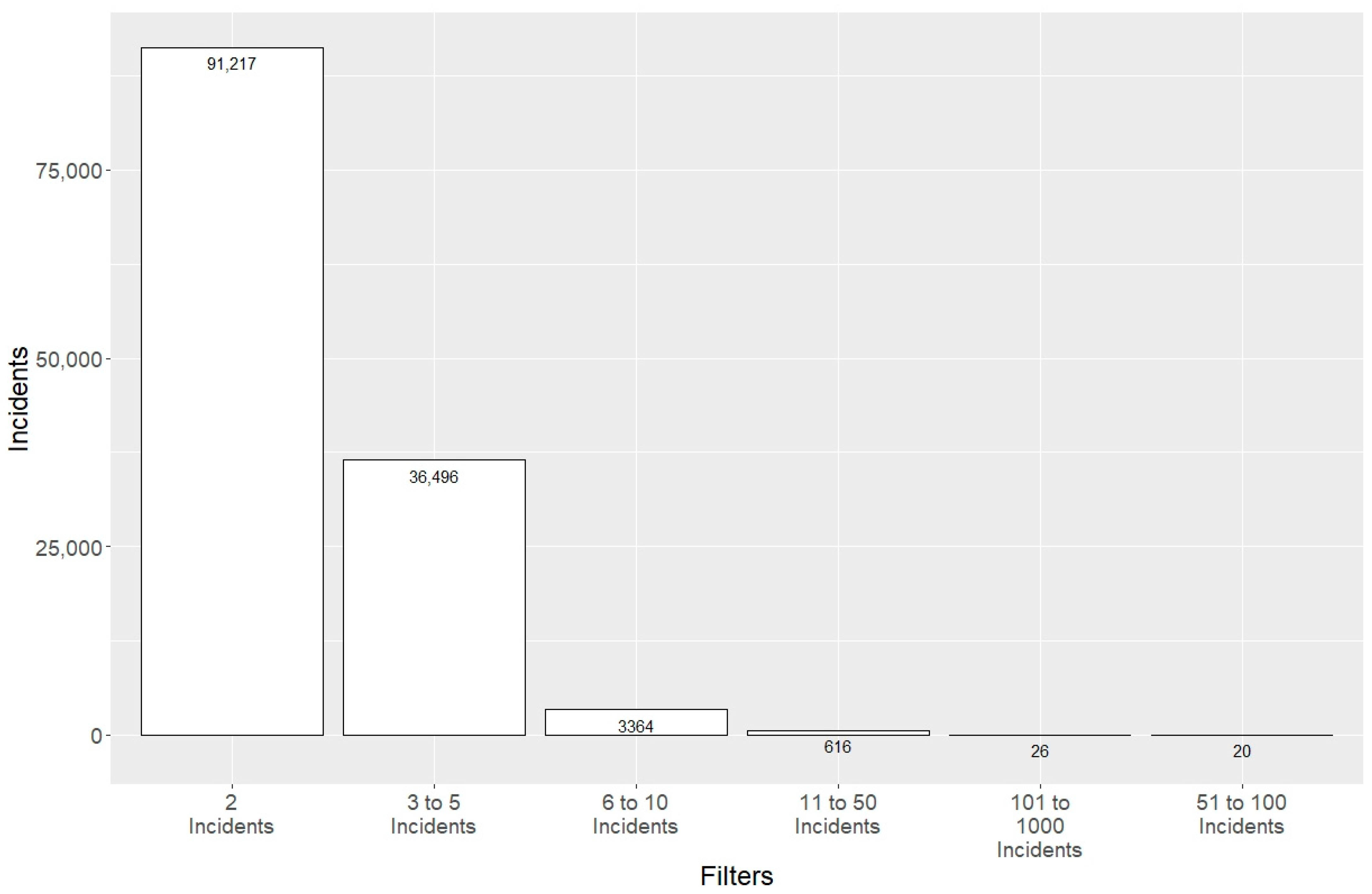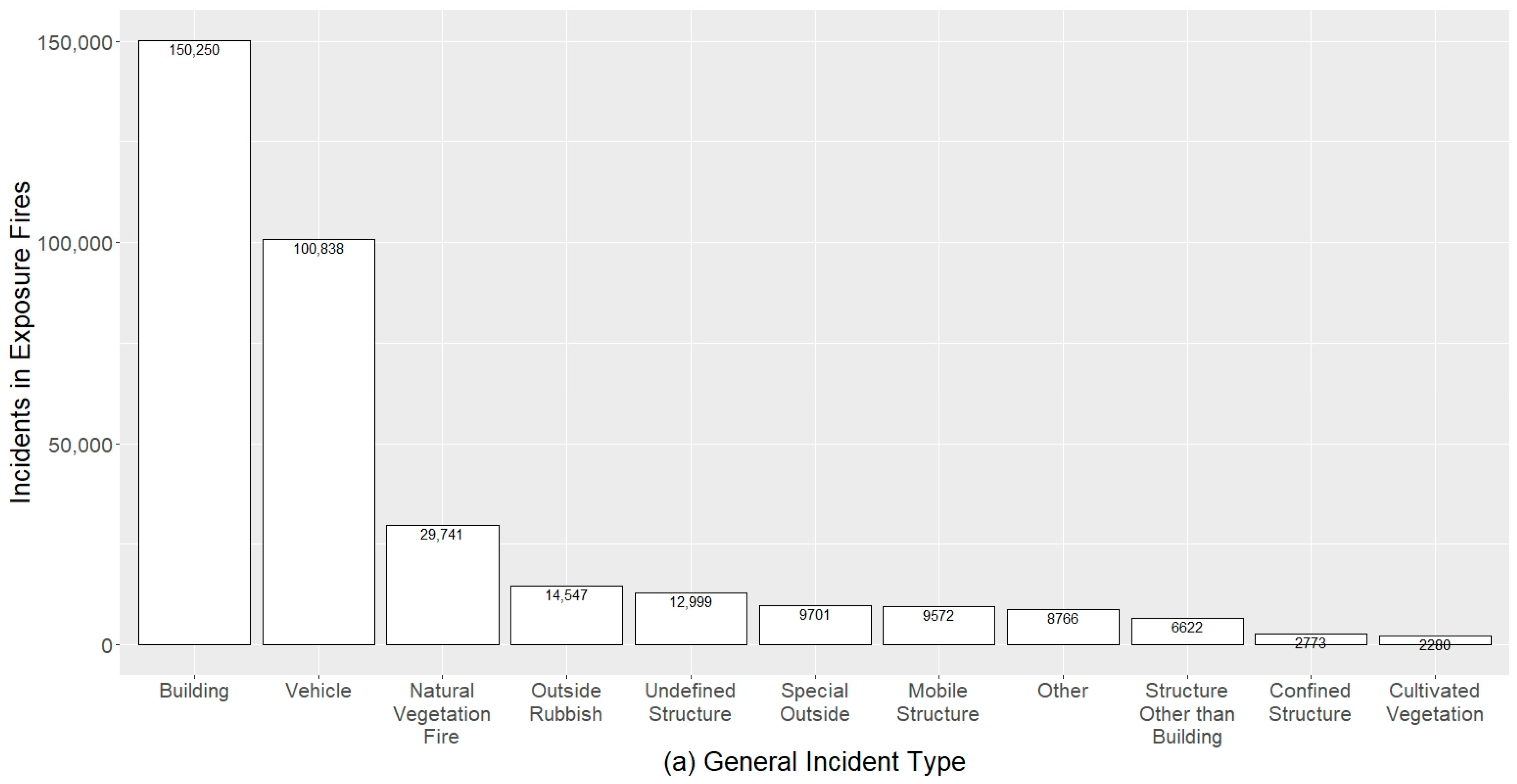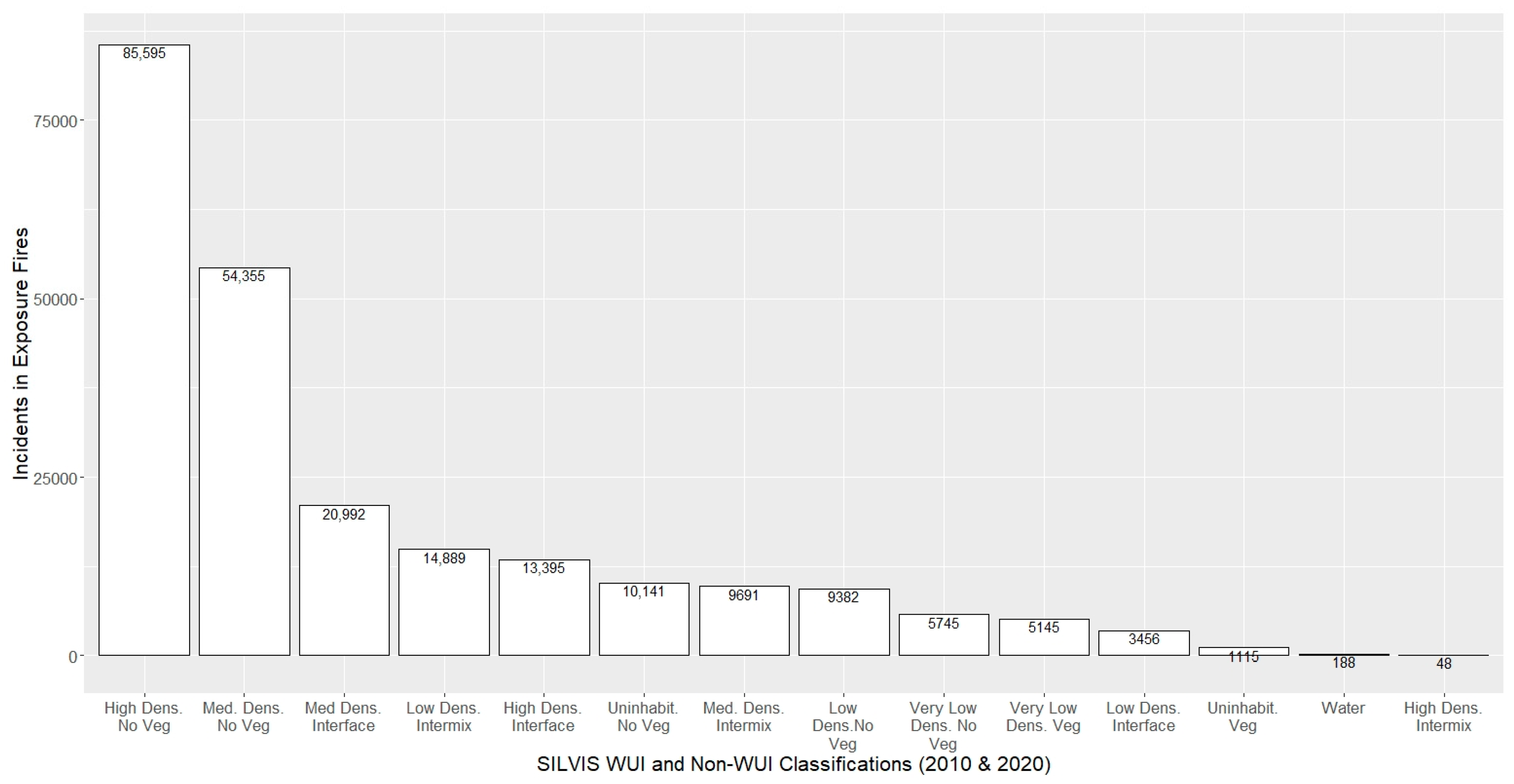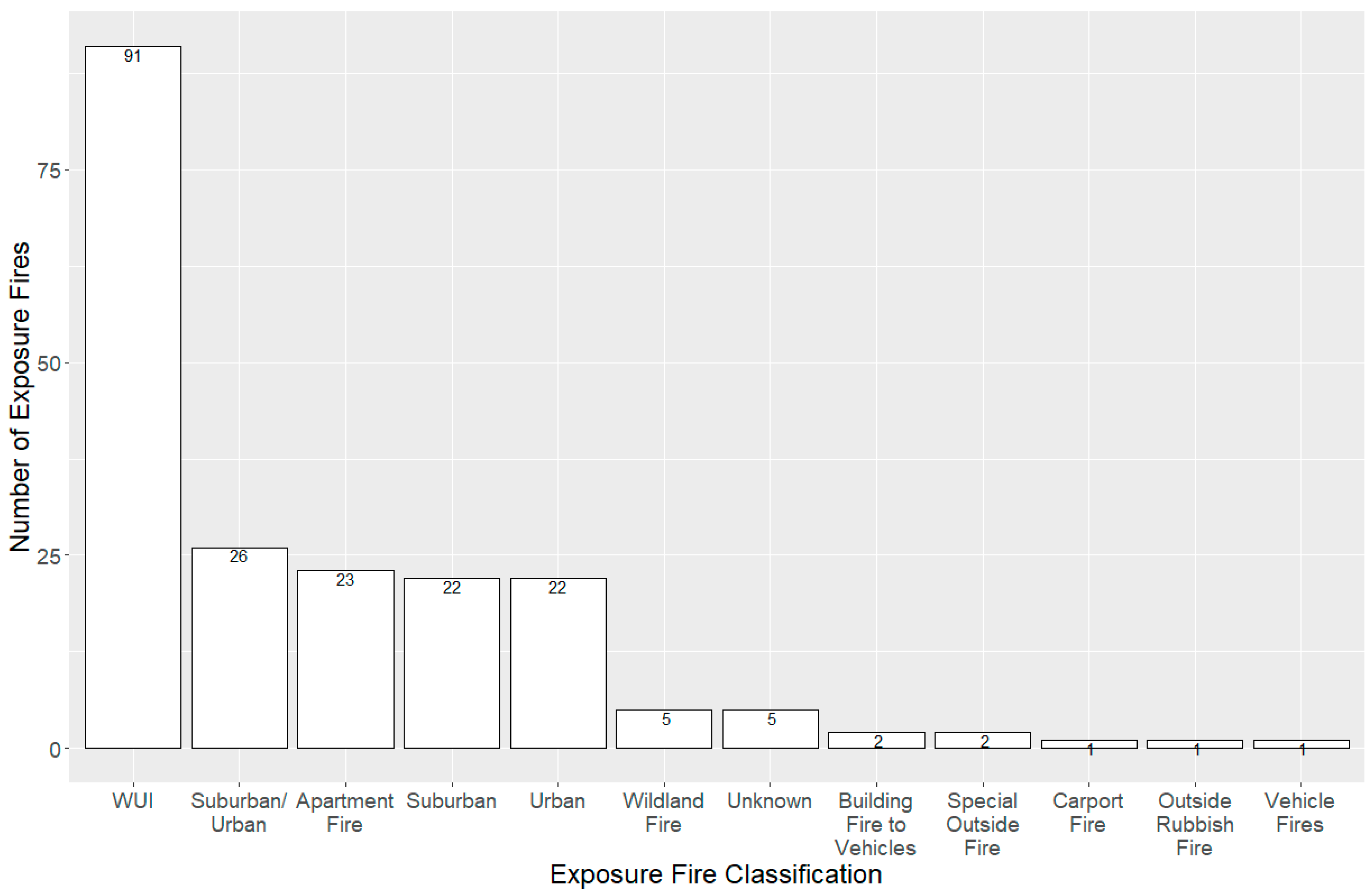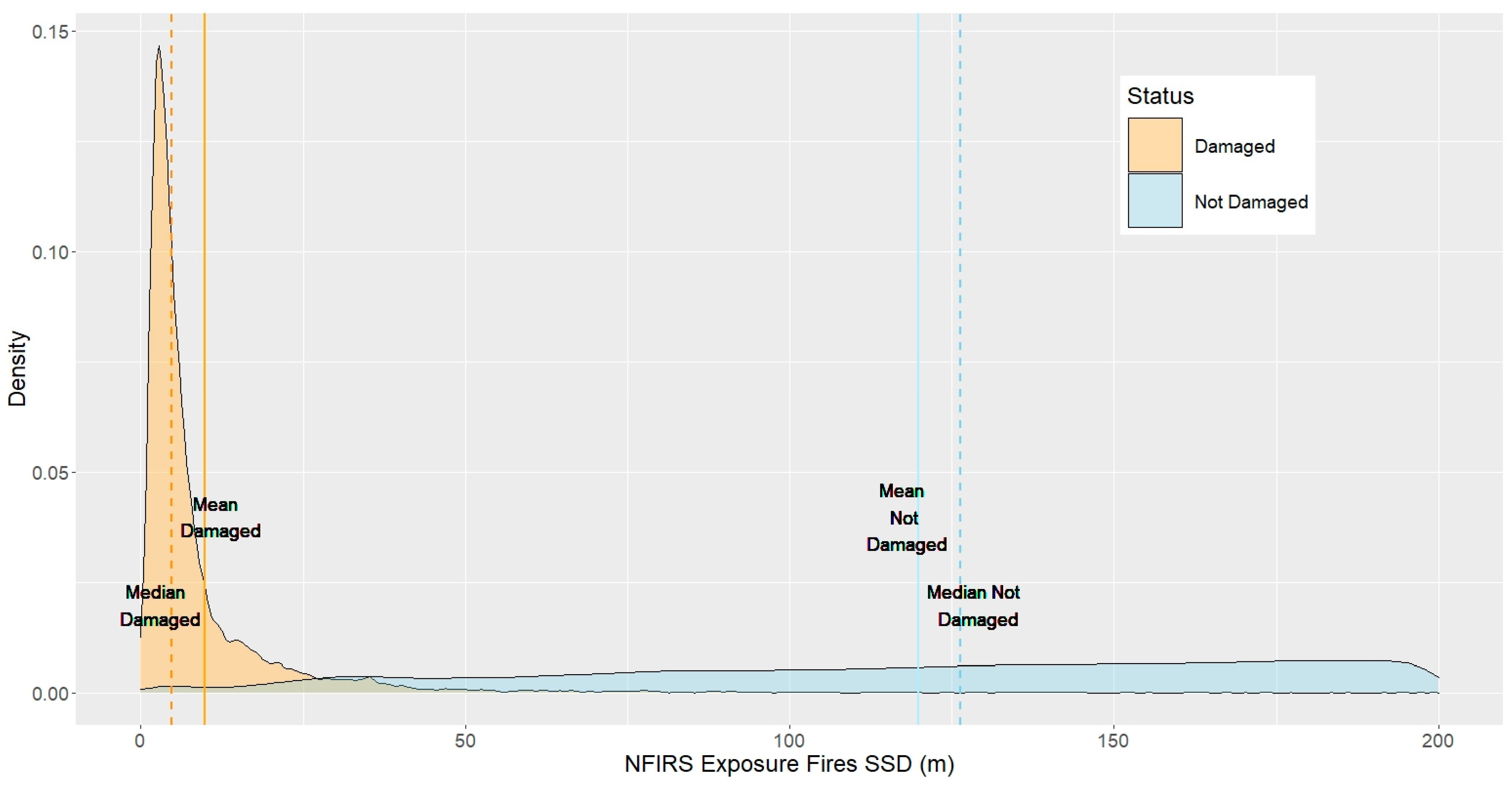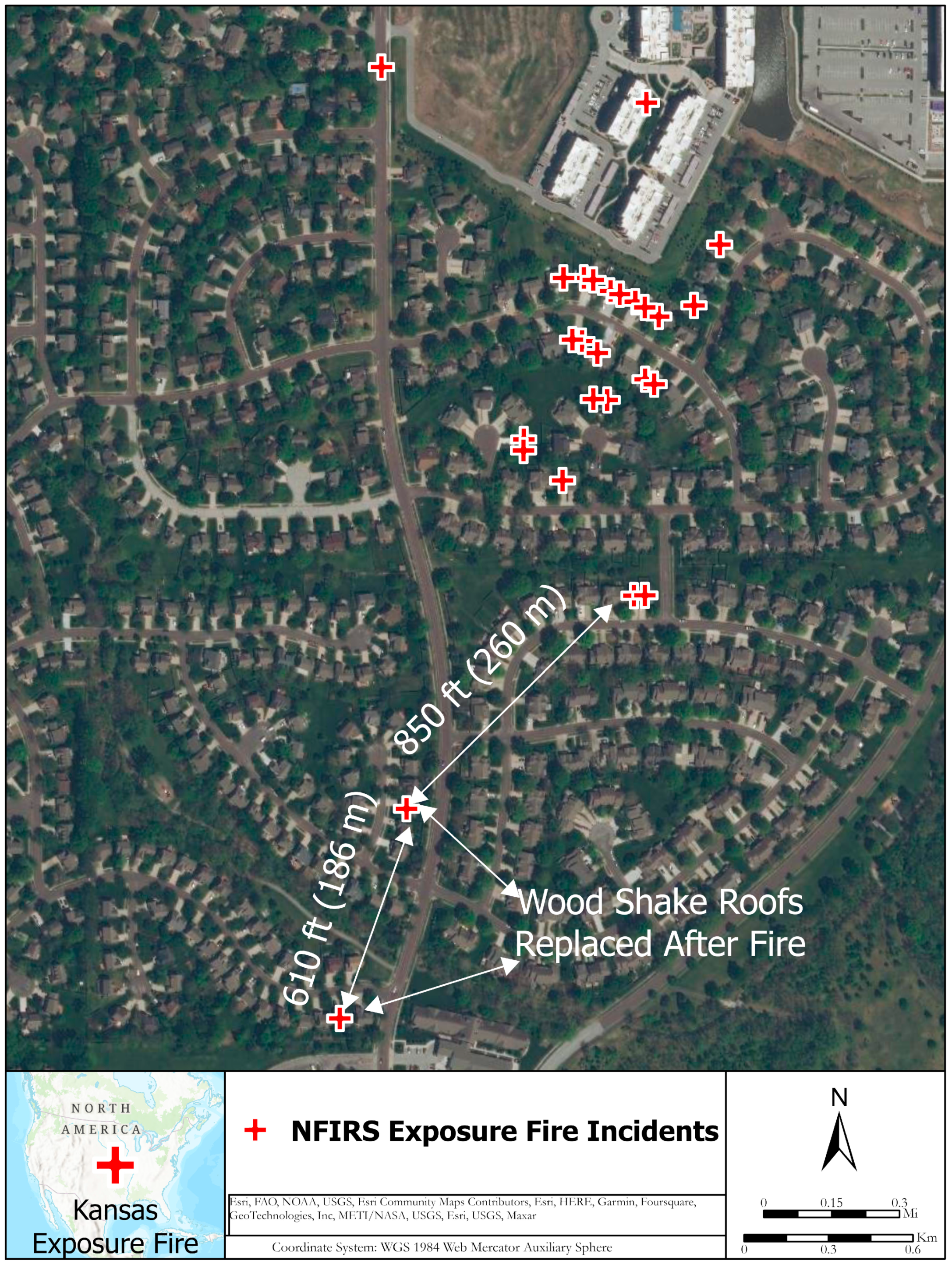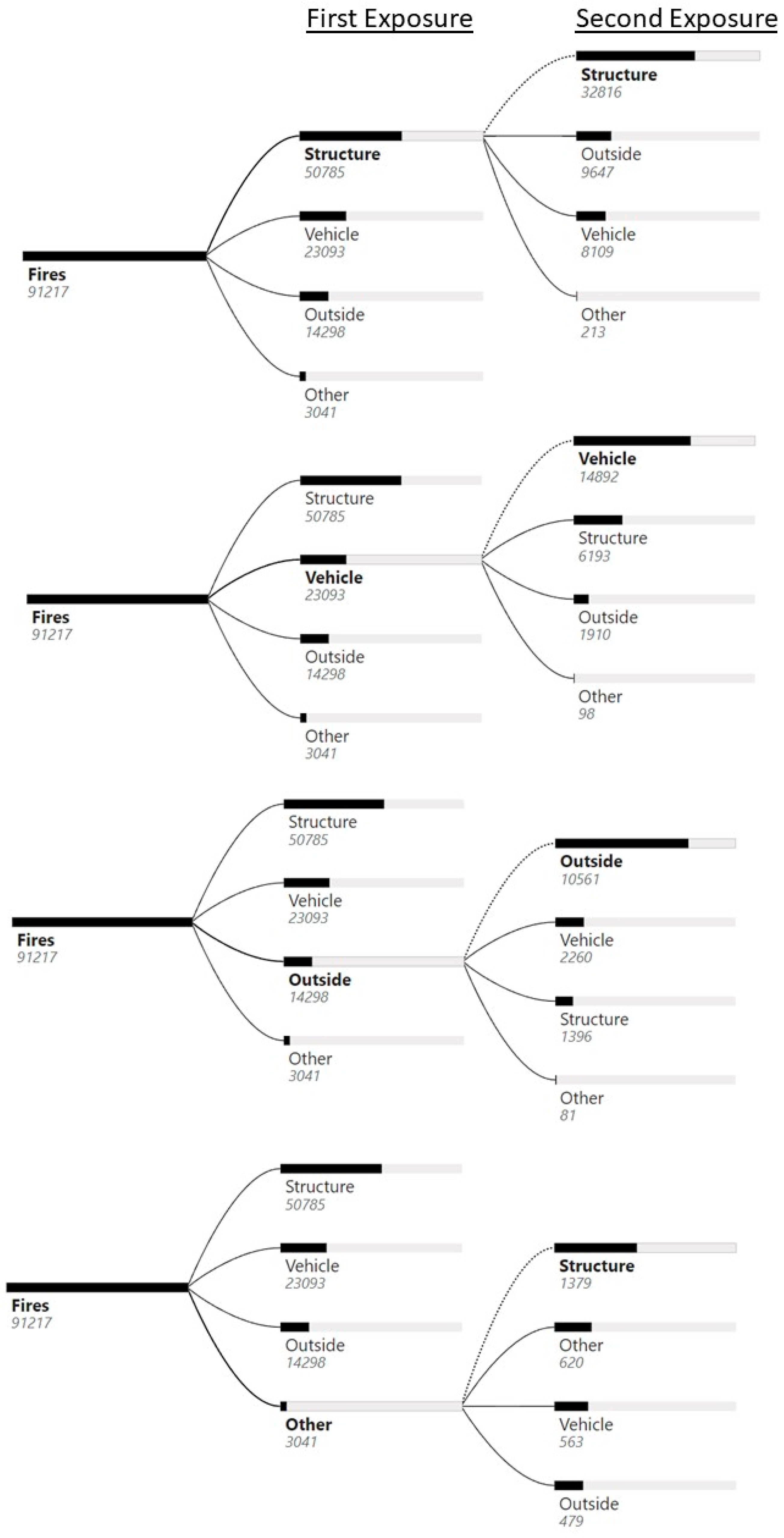1. Introduction
The largest fires in terms of structure destruction have occurred in recent years (e.g., 2023 Hawaii Lahaina Fire, 2021 Colorado Marshall Fire, 2020 Oregon Almeda Drive Fire, 2018 California Camp Fire, 2017 California Tubbs Fire, and 2016 Tennessee Chimney Tops 2 Fire). Structure destruction at these fires, while initiated by wildland fire, was primarily a result of urban conflagrations [
1]. Predictions of wildfires increasing due to climate change [
2,
3], accelerating housing growth [
4], increases in urban fires due to rising temperatures [
5], and escalating demands on firefighting resources [
6] emphasize the importance of examining structure conflagrations, and other exposure fires, in wildland–urban interface (WUI) and non-WUI environments.
The United States (U.S.) National Fire Incident Reporting System (NFIRS) [
7] defines exposure fires as “fires resulting from another fire outside that building, structure, or vehicle, or a fire that extends to an outside property from a building, structure, or vehicle [
7]”. The originating fire is termed a source fire and includes wildland fires [
8]. We refer to the combination of the source and the subsequent fire incident(s) as exposure fires, of which WUI and urban fires are a growing concern [
9,
10].
The WUI occurs where wildlands and human developments intersect. Fires in the WUI can also encroach into suburban and urban areas not classified as WUI [
1], resulting in significant structure conflagrations, such as in the 2017 California Tubbs Fire Coffey Park neighborhood. As resources become limited (e.g., gasoline and water in some locations) and meteorological conditions (e.g., drought and wind speed) become extreme [
3], suppressing exposure fires in the WUI and elsewhere can become more challenging, resulting in significant destruction, evacuations, and community disruption.
WUI fires occur when multiple structure ignitions from wildland fires overwhelm existing suppression capabilities [
9]. Containing these ignitions is challenging. Also, these ignitions can spread fire by heat fluxes from flames and embers to other structures (and features between structures, such as fences and vegetation). This fire spread can continue unabated until there is a change in conditions. For example, changes in wind, humidity, structure separation distance (SSD), human intervention, land use/land cover (LULC), building materials, or other factors might reduce the magnitude or effects of heat fluxes from flames and embers to the built environment and enable fire containment. Numerous studies (e.g., [
11,
12,
13,
14]) have attempted to unravel these complexities to determine the primary causes of structure destruction.
Still, current research has not quantified the exact contribution of different ignition mechanisms (heat, flames, embers) or the predominant source of heat flux (radiations, conduction, convection) leading to structure destruction over significant spatiotemporal extents. Furthermore, there is limited reliable information regarding the conditions leading to fire spread in exposure fires due to confounding factors in post-fire environments. For example, McNamara and Mell [
15] and McNamara, Mell, and Maranghides [
16] showed a dependence on the stopping of fire spread and indicators of defensive actions (e.g., evidence of water suppression) from eyewitness discussions and remote sensing data.
However, researchers have considered confounding factors in assessing structure response to fire, such as defensive actions, inconsistently. For example, Knapp et al. [
12] found few defensive actions at the 2018 California Camp Fire, excluding them as a predictor variable in their assessment. Conversely, Troy et al. [
13] found defensive actions to be the most critical predictor variable in their analysis. A growing body of research highlights the importance of defensive actions in assessing structure response at WUI fires (e.g., [
15,
16,
17]).
Compounding the difficulties in understanding the WUI problem is a lack of national databases representing the results of post-fire assessments and the full extent of structure destruction from exposure fires. However, NFIRS provides information on structures destroyed and damaged by fires involving numerous human-made and natural features. NFIRS is a voluntary system designed to report all fires and other incidents to which fire departments respond. Although NFIRS-reporting fire departments cover 71% to 83% of the U.S. population [
7], research has shown that the NFIRS only contains about 44% of all U.S fires [
18].
Additionally, Butry and Thomas [
19] found an underreporting of NFRIS-documented WUI fires in California between 2004 and 2013. However, they did not examine all reported exposure fires during this time. Existing examination of NFIRS exposure fires is currently limited. The U.S. Federal Emergency Management Agency [
8] analyzed exposure fires from the 2004 NFIRS database. The U.S. Fire Administration (USFA) [
20] examined NFIRS fires in the California WUI, including exposure fires, between 2009 and 2011. Finally, the U.S. Fire Administration (USFA) examined six large WUI fires in the U.S. [
21], including some incidents reported as exposure fires. While the above studies highlight the underreporting of WUI fires in the NFIRS to a limited extent, no study has examined NFIRS source fires to a significant spatiotemporal extent.
Identifying incidents occurring within known wildfire boundaries and the dates those wildfires occurred can provide information on NFIRS-reported structures affected by wildfires [
21]. This approach requires ancillary data (e.g., wildland fire perimeters) to identify affected structures. Additionally, wildland fire incidents can have information recorded in the NFIRS Wildland Fire Module, containing the number of structures ignited and threatened by the wildland fire. However, this approach does not document the locations of affected buildings, the type of affected building (e.g., outbuilding), or other affected features such as vehicles. Also, fire departments are not required to complete the NFIRS wildland module, resulting in limited data in this module [
19].
Studying NFIRS-reported exposure fires over a significant spatiotemporal extent might aid in understanding conditions that result in exposure fires, such as WUI fires that produce significant structure conflagrations. Consequently, in this study, we utilize NFIRS data covering U.S. and Puerto Rico reported between 2002 and 2020 to address the following questions:
What are the characteristics of exposure fires reported in the NFIRS regarding losses, affected features, defensive actions, heat sources, and locations?
How do NFIRS-reported large exposure fires (greater than ten features affected) compare to reported damage in other databases?
Can NFIRS exposure fires be used to assess the effects of structure separation distance (SSD) on structure-to-structure fire spread?
Can NFIRS exposure fires be used to assess ignition pathways present in these fires?
We also compare results from our examination of SSD and defensive actions in the NFIRS to conditions at the 2018 California Woolsey Fire (Woolsey Fire) [
11], which is not reported in the NFIRS, to highlight poorly founded assumptions in many WUI post-fire assessments. Addressing the above questions also provides insights into the characteristics needed in a database of exposure fires to aid the study of the growing WUI problem and other exposure fires.
2. Materials and Methods
The NFIRS is a voluntary database system designed to document the location, mitigation resources, losses, and other information for fire, hazardous material, explosion with no fire, and emergency medical service incidents responded to by fire departments [
7]. The NFIRS contains eighteen tables organized into a relational database schema [
22]. This study focuses on exposure fires documented in the BasicIncident, FireIncident, and IncidentAddress tables [
22].
The NFIRS records each fire incident (incident) in an exposure fire as a separate incident or record in the BasicIncident table. Each incident in an exposure fire should have a corresponding record in the FireIncident and IncidentAddress tables. Each incident in an exposure fire should have the same attribute values for state (the U.S. state where the incident occurred), fdid (a unique identifier for the fire department), date (the date of the incident), and inc_no (a unique identifier for the incident) in each of the three tables examined. The first incident or initially ignited feature should have a zero value for the exp_no attribute and is called a source fire [
8]. Subsequent incidents have values increased by one for each incident (e.g., structure or vegetation) in the exposure fire. An example of an NFIRS-reported exposure fire with three incidents is shown in
Figure 1.
In this study, NFIRS data between 2002 and 2020 were loaded to a PostgreSQL 11 database containing the NFIRS database schema [
22]. This database contained 22,575,246 records in the BasicIncident table, with 20,411,306 fire incidents. The structured query language (SQL) statements used to extract exposure fires are listed in
Appendix A.
The data produced from these queries were exported from the PostgreSQL database and imported into an ESRI™ File Geodatabase. Those exposure fire incidents in the exported dataset with sufficient location information (e.g., incidents with a specific address, including the house number) were then geolocated in ArcGIS Pro™ and loaded to the same File Geodatabase containing the tabular data.
The tabular dataset produced from the exposure fire queries (
Appendix A) was used to provide information about the reported characteristics of these exposure fires. This summary included the number of exposure fires, the total property loss and content loss reported, defensive action quantities by type, heat sources by type, and information about the incident type and property use. Also, geolocated exposure fire incidents were examined by 2010 WUI type [
23] for incidents before 2010 and 2020 WUI type [
23] for incidents occurring on or after 2010.
Additionally, exposure fires with greater than 20 incidents were examined. The type of fire (e.g., WUI, wildlands, suburban, urban, apartment only) was described based on examining the location in Google Earth™. Wildland fires contained only vegetative fire incidents. WUI fires contained at least one vegetative fire incident with a human-made fire incident type or, in some cases, contained no vegetative fire incidents but were known to be started by wildland fires (e.g., the 2016 Montana Roaring Lion Fire). Urban fires occurred in areas with limited to no vegetation. Suburban fires occurred in residential areas, and suburban/urban fires occurred in areas with a mix of suburban and urban areas as interpreted by overhead images in Google Earth Pro™.
For these larger exposure fires, it was determined if internet searchers (e.g., CAL FIRE incident reports) contained information on structures affected by the fire. If there was no publicly available information on structures affected, data from the SIT-209 report [
24], which collects and stores summary information (e.g., structures destroyed) on significant fire incidents, were examined. Finally, at the 2011 Texas Tanglewood Fire, a further comparison of the NFIRS-reported incidents against those documented from detailed post-fire ground assessments [
25,
26] was conducted to examine the potential underreporting.
Following the above, SSD was assessed for select NFIRS exposure fires. The Microsoft (MS™) dataset [
27] of building footprints (footprints) was used to calculate SSD between damaged-to-not-damaged and damaged-to-damaged residential structures. The SSD between the identified building footprints (representing incidents in exposure fires identified as described below) was calculated (
Figure 1) using a custom Python script in ArcGIS™ Pro 2.9. This script utilized the Near tool in ArcGIS™ Pro 2.9. The distance between footprints (polygons) is calculated as the closest distance between two polygon boundaries. If polygons overlap or touch, the distance is recorded as 0.
This SSD assessment required additional filters beyond those described in
Appendix A. First, the dataset of exposure fires was filtered for single or multifamily structures (i.e., inc_type equal to 111 and prop_use equal to 419 or 429). Geocoding of NFIRS exposures is often by address with the point location occurring on the primary structure (e.g., home). Consequently, other incident types (e.g., vehicles) could not be precisely located beyond the primary structure location.
Selecting only those incidents with an inc_type equal to 111 (building fire, not confined) and prop_use equal to 419 or 429 (one- or two-family dwelling or multifamily dwelling, respectively) resulted in some exposure fires with only one incident (e.g., an exposure fire where a vehicle ignited a home). These exposure fires with only one incident (i.e., no residential structure-to-structure fire spread occurred) were removed. After applying this filter, incidents containing information to geocode the feature at the structure level were identified. A subsequent filter excluded exposure fires on multifamily residences in one structure (e.g., apartment fires in the same structure).
The next filter ensured that the remaining exposures were consecutive (e.g., single-family structure to single-family structure). Therefore, incidents where the exp_no was not consecutive were removed (e.g., a three-exposure fire with two structures having exp_no of zero and two, respectively, and the second exposure with an exp_no of one was a vehicle and not geocoded). The remaining exposure fires also required a footprint in the MS™ dataset [
27], containing 129,591,852 footprints, coinciding with the geolocated incident. It was assumed that rebuilt destroyed structures would have a similar footprint design.
Because not all destroyed structures were rebuilt, the MS™ footprints might have missed the original structure, or the geocoded point did not fall within the structure. Therefore, another filter ensured that all remaining incidents were consecutive, as missed footprints might have resulted in exposure discontinuities. Finally, the MS™ footprints within 200 m of the filtered footprints representing damaged buildings were extracted to represent the not-damaged buildings. The reduction in exposure fires resulting from each filter is reported below.
The distributions of the two SSD calculations were compared visually using density plots. Also, the Kolmogorov–Smirnov test evaluated whether the two distributions come from the same population. Additionally, an examination like that described above for exposure fires with greater than 20 incidents occurred for those exposure fires used in the SSD assessment with equal to or greater than ten incidents.
Also, it is essential to note that our calculation of SSD is the minimum distance between footprints. In cases where parallel building walls exist, this distance likely captures SSD appropriately in characterizing the ignition hazard due to heat flux exposure from flames and hot gases. However, not all adjacent buildings have parallel walls, so the SSD measure utilized here might exaggerate the potential heat flux exposure from flames and hot gases.
Furthermore, errors in the spatial representations of footprints could result in erroneous SSD measurements. However, MS™ [
27] assessed the quality of the footprints, finding an intersection over union (measuring overlap quality against labels) value of 0.86, a shape distance value of 0.4 (similarity of polygon outline), and a dominant angle rotation error (polygon rotation deviation) of 2.5. Regardless, the assessment presented here is not intended to provide a quantitative measure of safe SSD; instead, it will only present general trends in the data and identify shortcomings and improvements to assessing SSD.
Ignition pathways (e.g., structure ignites a vehicle) are also examined. In theory, the order of values in the exp_no attribute represents the order of ignitions in exposure fires when there are two incidents in the exposure. The source fire ignited the feature in the second incident documented for these exposure fires.
These exposure fires are assessed for specific ignition pathways (e.g., vehicle to structure). It is more challenging to assess specific ignition pathways from exposure fires with three or more incidents due to ignitions not always being linear. For example, the building labeled as the first exposure (exp_no equals zero) in
Figure 1 caused damage to the second (exp_no equals one) and third exposures (exp_no equals two). However, in some cases, the second exposure might ignite the third exposure. Without ancillary data (e.g., post-fire imagery, as shown in
Figure 1), the ignition orders for exposure fires with more than two incidents cannot be determined.
Finally, comparisons between the NFIRS and Woolsey Fire SSD assessments [
11] are made, highlighting similarities between conditions in large structure destroying WUI fires and NFIRS exposure fires and common poorly founded assumptions present in many post-fire WUI studies. These assessments facilitate identifying some ideal characteristics for databases attempting to understand exposure fire characteristics better.
4. Discussion
We presented an extensive assessment of exposure fires from the NFIRS database, covering 19 years of reporting. Even when excluding large WUI fires not in the NFIRS, exposure fires represent a significant fire problem based on NFIRS-reported dollar losses over the period examined (conservatively, USD 5,647,121,172 in reported property losses and USD 1,777,345,793 in content losses). NFIRS-reported exposure fires primarily involve buildings, vehicles, and natural vegetative fires in residential, outside, and storage areas (
Figure 4). However, other features in different property types can be involved.
Some losses from NFIRS exposure fires (
Appendix B), particularly for exposure fires with limited incidents (e.g., less than ten), represent losses from WUI fires not reported in databases such as the SIT-209. The documentation of these smaller WUI fires can enable comparisons to WUI fires where destruction to human-made features is significant, thereby aiding our understanding of conditions that lead to substantial structure destruction, including encroachment of vegetative fires into urban or suburban areas not designated as WUI and structure-to-structure fire spread once a wildland fire enters a community. The NFIRS also reports on damage to features other than buildings, which other national databases in the U.S. do not, enabling the study of the effect of these features on exposure fires. A significant percentage (74%) of the exposure fires examined also occur outside areas mapped as WUI (
Figure 6).
However, at a fine scale, these non-WUI areas can look similar to areas mapped as WUI, with arbitrary lines that fire easily crosses, sometimes delineating the two environments (e.g.,
Figure 12). The exposure fires in
Figure 1 and
Figure 10 do not occur in WUI areas. Nonetheless, the environments are similar to areas in the built environment destroyed by WUI fires, such as those at the 2012 Colorado Waldo Canyon Fire [
16], the 2007 California Witch Fire [
29], the 2011 Texas Tanglewood Fire [
26], the Coffee Park Neighborhood Fire (
Figure 12), and many others.
Many NFIRS exposure fires occur in high-density areas with limited wildland vegetation (
Figure 6), highlighting the potential for large structure conflagrations in these areas, particularly with changing climate conditions, increased weather severity (e.g., wind and drought), and diminishing resources (e.g., gasoline and water). For example, as water becomes scarce in areas such as the U.S. desert southwest, suppression capabilities might be hindered, requiring increased vigilance regarding reducing initial ignitions in regions with historically high numbers of exposure fires.
Also, tracking exposure fires can aid in evaluating “Let it Burn” policies in urban areas with many abandoned structures. For example, the Detroit, MI area contains one of the highest densities of geolocated NFIRS exposure fires examined. This high density could partly be due to abandoned structures in this area and “Let it Burn” policies implemented to focus scarce firefighter resources [
32]. However, complete or incorrect reporting issues hinder statistical analysis of NFIRS exposure fires.
For example, a large number (108,684 or 33%) of the NFIRS-reported heat sources for exposure fires were missing. Also, NFIRS procedures list five acceptable heat source codes (80–84) representing heat spread from another fire for incidents in exposure fires after the source fire (i.e., exp_no greater than 0). These heat source codes capture direct flame and convection currents, radiated heat, embers, conducted heat, and other heat spread. However, not all documented heat sources were of these types, though some were similar, such as a spark, ember, or flame from operating equipment.
Radiated heat from another fire was the most numerous heat source for incidents with exp_no greater than zero. The next most numerous heat source was direct flame or convection currents, followed by unknown, heat spread from another fire (other), heat from open flame or smoking material, conducted heat from another fire, and flying brand, ember, spark, and hot ember or ash. Regarding the population of incidents (17,774 as shown in
Figure 2) used to assess SSD, a small percentage (2.2%) of the known heat_sour values were recorded as being from ember spread from another fire.
Some attributes, however, are reported more thoroughly than heat sources, such as defensive actions. Extinguishment occurs at most NFIRS exposure fire incidents (86%). The more extensive reporting of actions taken than heat sources could be because first responders were aware of their actions. However, the heat source that caused the ignition of other features might have been more difficult to discern and potentially confusing to document. Difficulties documenting heat sources at exposure fires highlight our lack of understanding of ignition mechanisms and the source of heat fluxes at exposure fires, even when they contain a limited number of features.
We also expanded upon the previously documented [
19] underreporting of NFIRS WUI fires, detailing the extent to which the large WUI fires reported in the NFIRS as exposure fires compared to estimates from other sources of damage and destruction (
Table 4 and
Appendix B). Our method of extracting exposure fires, in some cases, identified NFIRS WUI fires not previously reported in other studies. For example, Butry and Thomas [
19] identified zero structures reported in the NFIRS from the Witch, Rice, and Poomacha Fires. In contrast, the methods employed here identified 473, 208, and 15 buildings damaged from these three fires, which still significantly underestimates the buildings damaged by these fires.
Our analysis highlights that mutual aid incidents do not always seem to double count the incidents in exposure fires. At WUI fires, the fire department responding with mutual aid is responding to incidents that the local fire department might not have responded to due to their resources responding to other incidents. Therefore, excluding mutual aid fires from NFIRS exposure fires might further exacerbate the underreporting of WUI fires in the NFIRS because the method excludes incidents that are not double-counted in some cases. Having consistent location information for incidents would help identify when double counting occurs and when it does not, helping to identify exposure fires consistently in the future.
Many (45%) of the most significant exposure fires (incidents greater than ten) reported in the NFIRS are from WUI fires. Nonetheless, the NFIRS did not capture most large WUI fires from 2002 to 2020 as exposure fires (e.g., the 2018 California Camp Fire). When the NFIRS reports large WUI fires, they are often underreported, sometimes due to differences in reporting between jurisdictions (
Figure 8). In many cases, such as the 2011 Texas Tanglewood Fire, we document extensive underreporting of fire-affected features, highlighting the challenges for fire departments in documenting all the damage and destruction at moderate to large-sized exposure fires. More complete documentation of fire-affected features at the Tanglewood Fire required months (in terms of human-hours spent) of field data collection and office analysis using remote sensing data [
25,
26].
Evaluating SSD in NFIRS exposure fires is challenging. A significant issue curtailing the ability to calculate the separation distance between damaged features in NFIRS exposure fires was an inability to geolocate the feature. For example, the significant reduction in exposure fires (60%) and incidents (71%) resulting from the filters to identify single/multiple family residences (
Figure 2) was partly a geolocation issue because the NFIRS does not provide precise geolocation information for many fire incidents (e.g., vehicles). In some cases, improper geolocation could have resulted in the geolocated point being outside the building footprint, preventing a calculation of the SSD. The NFIRS geolocation information could be correct, but the geolocation engine failed to geolocate the address in the center of the footprint. Documenting precise location information, however, would further burden fire departments.
Despite the significant data reductions, this study examined SSD between single/multifamily structures across thousands of exposure fires, identifying a significant difference, though not necessarily representative of the national exposure fire problem, in the SSD distributions between the damaged-to-damaged and not-damaged-to-damaged structures within 200 m of the damaged structures. The probability of finding a damaged structure near another damaged structure peaks when the SSD is about 3 m. However, this peak should not be used to indicate a safe SSD in exposure fires, as many factors can affect an appropriate SSD to curtail fire spread. For example, the significant difference in SSD distributions is partly due to the fire containment by first responders.
The large percentage (86%) of exposure fires where defensive actions could have altered heat fluxes coupled with the difference in the mean percent of property loss for the first exposure (81%; exp_no equals 0) and the mean of property loss for subsequent incidents (51%; exp_no greater than 0), highlights that exposure fires occur when fires in the initial incident produce more destruction. This pattern is due, in part, to a lack of containment of the initial fire. The fact that subsequent exposures have a lower percentage of property loss (51% compared to 81%) suggests more successful fire containment. Therefore, most of the not-damaged buildings within 200 m had fire spread curtailed by these defensive actions (potentially coupled with other factors not assessed here, such as wind speed, topography, fuels between the structures, and others), resulting in the increasing probability of a not-damaged building occurring the further it is from a damaged building, as shown in
Figure 9.
This intuitive finding is similar to previous studies of larger WUI fires that have also found a relationship between building survival and the distance to the closest destroyed building (e.g., [
11,
12]). These studies assume limited or no defensive actions. However, indicators of defensive actions [
15,
16] exist throughout the post-fire imagery [
33,
34] and in the damage inspections from the California Department of Forestry and Fire (CAL FIRE).
For example, post-fire imagery of the Woolsey Fire (
Figure 13) shows similar indicators of defensive actions as those seen in the destroyed structure (exp_no equals 0) in
Figure 1 (i.e., a darkened appearance of some destroyed structures due to the cessation of the combustion process through extinguishment), and similar to those documented at other exposure fires [
15,
16]. Suppose structure fires are allowed to burn without suppression. In that case, they have a white appearance when containing mostly combustible items, indicative of white ash produced by complete combustion when a building and its contents burn more completely, as highlighted in one of the upwind structures shown in
Figure 13. Also, damaged buildings are a well-established [
9,
15,
16,
26,
29] indicator of defensive actions, further validated in this study of thousands of fires.
Consequently, the finding that the distance to the destroyed building is the most important predictor of structure survival at the Woolsey Fire [
11] is partly due to defensive actions. Without the defensive actions shown in
Figure 13 and present throughout high-density areas at the Woolsey Fire and other locations, there is no evidence that fire spread between structures in these areas, particularly high-density areas (SSD less than 3 m), would have ceased. Nevertheless, as in other studies [
12], this study of the Woolsey fire [
11] assumed that defensive actions were limited and did not include them as a predictor variable.
Analyzing NFIRS exposure fires identifies the importance of including the effects of defensive actions, which are often assumed not to be relevant (e.g., [
11,
12]) when analyzing larger WUI fires. As shown here, defensive actions are prevalent in exposure fires nationwide. Large exposure fires can overwhelm defensive resources, as they did at the Woolsey Fire. Nonetheless, defensive actions can still be significant. They might be necessary to curtail fire spread in large exposure fires, as also shown in other studies [
15,
16,
17,
26,
29].
Other factors not examined here might also contribute to preventing or reducing fire spread in exposure fires, including weather (e.g., wind), building material, and undocumented features between the structures. Consequently, obtaining a quantitative understanding of the role of low SSD from current NFIRS exposure fires would be challenging across significant extents or even at individual fires without ancillary information (e.g., videos, images, eyewitness accounts, and measurements of heat fluxes and meteorological conditions).
Additionally, we are not sure that building damage resulted from fire spread directly between single/multifamily residences in all cases. There might have been undocumented fire incidents between structures that caused damage. For example, in some cases, we observed fences before and not after the fire in Google Earth™ Imagery between two or more single/multifamily structure incidents. The fences might have ignited, resulting in subsequent structural damage. The fire department might not have documented these more minor incidents as observed at the 2011 Texas Tanglewood Fire. This uncertainty highlights the need for experimental efforts (e.g., [
36]) to understand better the role of SSD in fire spread. However, researchers can use databases like the NFIRS to help guide experiments.
Caution should be used in quantitatively interpreting results on ignition pathways as the potential underreporting of minor features between fire incidents (e.g., fences between homes) could be underestimated. Also, underreporting of large WUI fires curtails deciphering ignition pathways from NFIRS exposure fires as representative of the distributions of ignition pathways across the U.S. Nonetheless, we highlight situations (e.g., NFIRS-reported exposure fires with two incidents) where the NFIRS potentially identifies ignition pathways.
Interestingly, when the first incident in these two exposure fires is a structure, the second incident tends to be a structure, and this same pattern holds for vehicles, outside fires, and other fires. This similarity could be because features of similar types are found next to each other. This finding supports the role of smaller SSDs in fire spread, as these features must be in proximity to ignite each other. Nonetheless, NFIRS-reported exposure fires identify many possible ignition pathways, highlighting that fires do not always spread to the same feature. Also, future studies might utilize the alarm attribute, which theoretically identifies the time of the ignition to identify ignition pathways in fires with more than two incidents. However, recreating these fire timelines to capture ignition pathways precisely is challenging.
NFIRS exposure fires also provide information on ember spread at exposure fires, particularly when combined with ancillary information. For example, when integrated with active-fire overhead imagery [
30] and pre-fire Google Earth™ aerial and StreetView imagery, we could confirm structure-to-structure ember spread over a significant distance (at least 260 m), also highlighting the risk of wood shake roofs in ember fire spread. Integrating these exposure fires with ancillary data, such as images and videos, can increase the understanding of factors and mechanisms affecting fire spread in exposure fires.
In many cases, first responders cannot respond to many incidents at large exposure fires because the number of ignitions overwhelms resources. Therefore, exposure fires with numerous incidents tax the NFIRS [
21]. Nonetheless, if resources exist, information from exposure fires, including smaller WUI fires, could be captured using the NFIRS or NFIRS modernization efforts such as the National Emergency Response Information System (NERIS) [
37], which currently aims to provide predictive analytics for WUI fires. Combined with the SIT-209 database, which portrays structure destruction from large WUI fires, the NFIRS and NERIS can add to our understanding of WUI fires by providing information on smaller fires not documented in the SIT-209 database. This approach would require a mechanism to identify incidents between different databases (e.g., NFIRS, NERIS, and SIT-209).
The NFIRS or NERIS could also be used to document select incidents from large WUI fires that are responded to by fire departments, thereby efficiently providing some data for post-fire studies that have required significant effort to obtain defensive action information (e.g., [
26,
29]). Finally, using NFIRS special studies fields or new fields in modern systems such as the NERIS to capture additional details could aid our understanding of exposure fires and SSD, as
Appendix C identifies. However, these new fields would also increase the reporting burden of first responders, which is already challenging.


